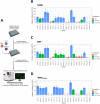CRISPR activation as a platform to identify interferon stimulated genes with anti-viral function
- PMID: 38258394
- PMCID: PMC11165661
- DOI: 10.1177/17534259231225611
CRISPR activation as a platform to identify interferon stimulated genes with anti-viral function
Abstract
Interferon Stimulated Gene (ISG) expression plays a key role in the control of viral replication and development of a robust adaptive response. Understanding this dynamic relationship between the pathogen and host is critical to our understanding of viral life-cycles and development of potential novel anti-viral strategies. Traditionally, plasmid based exogenous prompter driven expression of ISGs has been used to investigate anti-viral ISG function, however there are deficiencies in this approach. To overcome this, we investigated the utility of CRISPR activation (CRISPRa), which allows for targeted transcriptional activation of a gene from its endogenous promoter. Using the CRISPRa-SAM system to induce targeted expression of a panel of anti-viral ISGs we showed robust induction of mRNA and protein expression. We then employed our CRISPRa-SAM ISG panel in several antiviral screen formats to test for the ability of ISGs to prevent viral induced cytopathic cell death (CPE) and replication of Dengue Virus (DENV), Zika Virus (ZIKV), West Nile Virus Kunjin (WNVKUN), Hepatitis A Virus (HAV) and Human Coronavirus 229E (HCoV-229E). Our CRISPRa approach confirmed the anti-viral activity of ISGs like IFI6, IFNβ and IFNλ2 that prevented viral induced CPE, which was supported by high-content immunofluorescence imaging analysis. This work highlights CRISPRa as a rapid, agile, and powerful methodology to identify and characterise ISGs and viral restriction factors.
Keywords: Antiviral; CRISPR activation; interferon stimulated genes; virus.
Conflict of interest statement
Declaration of conflicting interestsThe authors declared no potential conflicts of interest with respect to the research, authorship, and/or publication of this article.
Figures








References
-
- Schoggins JW. Interferon-stimulated genes: what do they all do? Annu Rev Virol 2019; 6: 567–584. - PubMed
Publication types
MeSH terms
Substances
LinkOut - more resources
Full Text Sources
Research Materials
Miscellaneous

